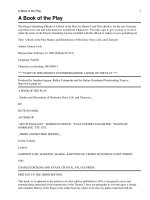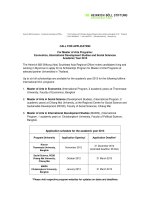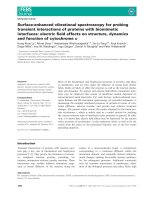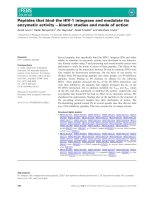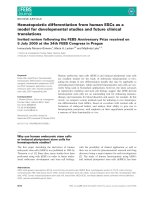Ubiquitous Computing for Firefighters Field Studies and Prototypes of Large Displays for Incident Command
Bạn đang xem bản rút gọn của tài liệu. Xem và tải ngay bản đầy đủ của tài liệu tại đây (3.09 MB, 9 trang )
Ubiquitous Computing for Firefighters: Field Studies and
Prototypes of Large Displays for Incident Command
Xiaodong Jiang1, Jason I. Hong1, Leila A. Takayama2, James A. Landay 3
Group for User Interface Research
Computer Science Division
University of California
Berkeley, CA 94720-1776, USA
{xdjiang, jasonh}@cs.berkeley.edu
1
Department of Communication
Stanford University
Stanford, CA 94305-2050, USA
2
Abstract
In this paper, we demonstrate how field studies,
interviews, and low-fidelity prototypes can be used to
inform the design of ubiquitous computing systems for
firefighters. We describe the artifacts and processes used
by firefighters to assess, plan, and communicate during
emergency situations, showing how accountability affects
these decisions, how their current Incident Command
System supports these tasks, and some drawbacks of
existing solutions. These factors informed the design of a
large electronic display for supporting the incident
commander, the person who coordinates the overall
response strategy in an emergency. Although our focus
was on firefighters, our results are applicable for other
aspects of emergency response as well, due to common
procedures and training.
Categories & Subject Descriptors: H.5.2
[Information Interfaces and Presentation]: User
Interfaces – user-centered design
General Terms: Human Factors
Keywords: Firefighter, field study, low-fidelity
prototypes, emergency response, ubiquitous computing
INTRODUCTION
In the United States, more people are killed by fires than
all other natural disasters combined. Each year, there are
about 1.9 million fires, killing about 4000 people and
injuring 25,000 more, including about 100 firefighters
killed in the line of duty. Furthermore, fires cause on the
order of $11 billion USD in property damage per year
[18, 23].
Firefighting is clearly a dangerous profession. Firefighters
must make quick decisions in high-stress environments,
constantly assessing the situation, planning their next set
of actions, and coordinating with other firefighters, often
with an incomplete picture of the situation. One
Permission to make digital or hard copies of all or part of this work for
personal or classroom use is granted without fee provided that copies are
not made or distributed for profit or commercial advantage and that
copies bear this notice and the full citation on the first page. To copy
otherwise, or republish, to post on servers or to redistribute to lists,
requires prior specific permission and/or a fee.
CHI 2004, April 24–29, 2004, Vienna, Austria.
Copyright 2004 ACM 1-58113-702-8/04/0004...$5.00.
3
DUB Group
Dept of Computer Science and
Engineering
University of Washington
Seattle, WA 98195-2350
firefighter we interviewed summarized it best:
“Firefighting is making a lot of decisions on little
information.” Improvements in existing tools and
practices can help protect civilians and firefighters, as
well as minimize property damage.
Currently, firefighters make very little, if any, use of
computers when on the scene of a fire, since most
commercially available computers are designed for office
work. However, ubiquitous computing technologies are
providing a remarkable opportunity for change. The
convergence of small, cheap sensors (e.g. [12]) coupled
with wireless networking and computing devices in a
variety of form factors offers the tremendous potential to
gather and communicate critical information in real-time
—such as temperature, toxicity, and a person’s location
and health status—at unprecedented levels.
A key question here is how to design systems such that
this sensing power can be used effectively. What
information should be gathered, who needs to know about
it, and how should it be presented and used? To answer
these questions, we conducted a series of studies with
firefighters, observing a training exercise in the field,
carrying out interviews, and iterating on several lowfidelity prototypes. These methods allowed for
opportunistic discovery and limited commitment to
preconceived notions of this domain. The main goal of
these studies was to understand the tacit knowledge about
procedures, tools, and dangers that are rarely documented
in textbooks, and to use these to inform the design of
appropriate ubicomp systems for firefighters.
Firefighters use a para-military organization with welldefined ranks and roles [10]. Ranks are fixed titles, such
as battalion chief, captain, and lieutenant. Roles represent
a set of responsibilities and help establish the chain of
command. While our studies involved firefighters of
various ranks, it focused on the role of incident
commander (IC). The IC is an information intensive
position, which involves coordinating the overall response
strategy to an emergency and managing available people
and resources in real time. This observation led us to
focus on supporting ICs early on. Our subsequent field
studies influenced the design of our prototype, a large
electronic display for supporting ICs.
The rest of this paper is organized as follows. After
related work, we provide background information about
the organizational structure and procedures used by
firefighters. We then present key findings from our
studies with firefighters. Next, we discuss how those
findings informed our designs, and show how our lowfidelity prototypes evolved based on feedback from ICs.
We conclude by discussing issues in designing ubicomp
applications for firefighters and for emergency response.
RELATED WORK
There is a great deal of existing literature about
firefighters, for example, their organizational structure
[20, 24], decision-making processes [13], and
psychological and health conditions [19, 20]. There have
also been several studies of failures, some notable ones
being procedural failures in Massachusetts [15],
McKinsey and Co.’s report on the World Trade Center
attacks [14], and a study of organizational and
communication failures at Mann Gulch [24]. While this
research informed us, it was limited in helping us
understand what kinds of situational information would
be useful for firefighters and in designing ubiquitous
computing systems for firefighters, especially for incident
commanders. Thus, our work here is complementary,
concentrating on building appropriate tools for
firefighters.
There has been some work in the CHI community that
could be used to help firefighters, in mobile and wearable
computing (e.g., [17]), hands-free and eyes-free
interaction [2], and management of simultaneous
conversations [1]. Since the smoke-filled conditions of
structure fires significantly decreases visibility, there are
also potential overlaps between studies of interfaces for
blind users (e.g., [9, 22]) and studies of interfaces for
firefighters.
The Command Post of the Future [6] is a set of projects
investigating command in battlefield situations. The focus
is on developing technologies for mobility and better
decision-making, including multimodal interaction,
information
visualization,
and
knowledge-based
reasoning. We complement this work by looking at user
needs for a related but different domain, focusing on
information presentation and interface design for large
displays.
In the CHI community, our work is most related to Camp
et al., who looked at communication issues in
emergencies and prototyped a radio system that would
reduce congestion while maintaining situational
awareness [3]. In contrast, we concentrate more on
incident command and how a large display can help
support that role.
For the most part, however, there has been relatively little
HCI work done on emergency response. While the CHI
community has historically focused on non-emergency
situations, typically office environments, we see
emergency response as an area where the community can
contribute significantly. Advances in the state of the art
can help save lives as well as minimize injuries and
property damage.
The CHI community itself can also benefit from research
in this area. The nature of emergency response is
fundamentally different from office environments, in
terms of physical risk, psychological state, and operating
conditions that are dynamic and often extreme . This
poses unique challenges for designers and researchers in
terms of group awareness, multimodal interaction, and
information visualization, to name a few. If we can make
an impact in this highly stressful domain, where the
systems we offer are secondary to the primary task, we
might also be able to apply these results in less extreme
environments for a wider audience, such as computing
while driving.
BACKGROUND
This section describes background information about the
organizational and command structure of firefighters,
with an emphasis on incident commanders. This
information is part of the standard training for
firefighters, and can be found in training textbooks (for
example, [10, 21]).
Organizational Structure
The basic unit of organization for firefighters is the
company, which is “any piece of equipment having a full
complement of personnel” [10, 16]. Companies are
typically comprised of a captain, a driver or engineer, and
one or two firefighters, though this can vary. The captain
is the officer in charge of a company. The engineer
operates vehicles, pumps, and other equipment.
A battalion is a collection of companies permanently
responsible for a geographic area, such as a city or county.
A battalion has several battalion chiefs (BCs) that are
responsible for all operations within a specified
timeframe, typically 24 hours. BCs arrive on scene to
assume command for structure fires and other large
incidents, but are usually not involved with smaller
incidents.
If an incident is large enough, firefighters are organized
into divisions, which operate within a specific geographic
region (e.g. north, third floor, or main entrance), and
groups, which perform specific functions not restricted to
a geographic area (e.g., rescue or ventilation).
Incident Command System (ICS)
All emergency responders use some command system to
manage the overall response to an incident, the most
common of which is the Incident Command System (ICS).
ICS has been adopted by many local, state, and federal
agencies in North America to handle emergencies of all
kinds. ICS is also supported by various artifacts and
procedures to help the command team assess, plan, and
communicate with everyone involved in the incident.
ICS defines five major roles [5, 10]: command,
operations, planning, logistics and administration. We
only focused on the first three of these in our field
studies. Command is responsible for all incident
activities, including developing and implementing a
strategic plan. The person in overall command is the
incident commander. Operations manages tactical
operations to implement the overall strategic plan.
Planning is in charge of collecting, evaluating, and
disseminating information such as maps, weather reports,
road closures, and status of personnel and resources.
These roles are flexible. The ranking officer of the first
team on scene might assume the role of IC and carry out
all ICS roles, passing on the role of IC to higher-ranking
officers arriving later on and assuming another role.
Firefighters rely on a chain of command where each
person reports to exactly one supervisor. The chain of
command also describes communication pathways
between responders. In small incidents, for example, an
IC would send a message directly to the captain of a
company, but in large incidents, that message might be
relayed from Operations, to the division leader, and then
to the captain.
It is also standard procedure for firefighters to maintain a
manageable span of control. As one interviewee said,
“The idea behind ICS is you break it down so that one
person is in charge of one small component. It’s easier to
manage that way. It’s based on an old military tradition
[of using] the easiest span of control - 5 to 7 [people].”
This principle is applied from companies all the way up to
ICs. For example, in a small structure fire, the IC might
also assume the role of Planning, Operations, and
Logistics, but in larger incidents would delegate these
roles to other officers, possibly with entire support teams
to assist them.
EXAMPLE: A SINGLESTORY HOUSE FIRE
We present a hypothetical scenario to illustrate some key
tasks and procedures involved in responding to a
structure fire. After a single-story house fire is reported
and confirmed, the 911 dispatcher immediately notifies
the nearest fire station. Depending on the perceived scale
of the fire, different alarms may be called, which commit
a predetermined number of emergency response resources
to be dispatched. For example, in a suburban setting, a
first alarm might call for three engines, a truck, and a
battalion chief, and a second alarm might call for four
additional fire engines, another truck, and a hazardous
materials team.
When the first engine arrives, its captain takes a quick
look around to size-up the situation, taking in such factors
as hazards, weather, and safety in developing a plan of
attack. At the same time, firefighters are sent out to
understand the building layout, surrounding areas, and
location and scope of the fire. The engineer is responsible
for locating the fire hydrants and setting up the fire hose.
The highest ranking member (in this case, the captain)
assumes the role of IC.
If the incident is large enough, the on-duty Battalion
Chief will also go on scene. BCs often drive a separate
vehicle that contains equipment and forms needed for a
command post (see Figure 1). A BC will typically set up a
command post close enough to see the fire but far enough
to maintain safety. Once the BC arrives, the role of IC is
Figure 1. Rearview shot of a Battalion Chief’s truck, which
contains many forms and equipment for ICs.
Figure 2. Grease board often used by ICs. The left shows
the command hierarchy. The top-right shows a checklist of
things to do. The bottom-right is for sketching maps.
passed on to him. The new IC gets a quick status report of
what they have, who they have, where they are, what
tasks they are doing, where the fire is going, and what
else needs to be done. He might also use a grease board
(see Figure 2) or some standard forms (see Figures 3a and
3b) to sketch out the local area, help keep track of tasks,
communicate information to others, and maintain a record
of the incident for post-mortem analysis and training.
These tools are often used at the back of the BC’s truck
(see Figure 1).
ICs develop plans of attack based on information from a
variety of sources. The highest level strategy is to go
either offensive, fighting the fire directly, or defensive,
preventing the fire from spreading. Once the IC is
satisfied that the fire has been extinguished, he releases
all resources and returns to the fire station.
DESCRIPTION OF FIELD STUDY
Our field study spanned four months and included over
30 hours of interviews and user testing with 14
firefighters in 3 fire departments. Among them were 1
assistant chief, 4 battalion chiefs, 2 captains, 2 engineers
and 5 firefighters. We chose to focus on firefighting of
structural fires in urban areas, but due to common training
methods and standard operating procedures, we believe
our findings will be broadly applicable to other types of
emergencies. Again, our goal was to understand the tacit
knowledge about procedures and problems that are not
typically documented.
position in which computers could help more readily. We
discuss our findings most relevant to ICs below.
(a)
(b)
Figure 3. Two sample ICS forms from [8]. The top (a) is a
sketch of the area and location of resources. The bottom
(b) tracks what resources are available, what tasks have
been assigned, and what resources are en route.
Figure 4. Passports in a fire station. A tag has the name of
a firefighter. Each group of tags represents a company.
We conducted interviews at fire stations, which helped us
learn about their organizational structure, tools, routines,
regular interactions, and typical environment. We also
observed one field exercise in which new firefighters
were trained on firefighting tactics for urban structures.
In addition, we accompanied firefighters on two calls to
see first hand how they accomplished their tasks.
Throughout, we collected artifacts such as actual Incident
Action Plans, accountability forms, ICS Forms, ICS
booklets, and recordings of radio communication on real
incidents.
We began focusing on incident commanders early in our
field studies since it was an information intensive
Accountability
Accountability is pervasive throughout the organizational
structure, procedures, and equipment of firefighters.
Accountability ensures that there is an accurate count of
resources and personnel on scene, with rapid notification
if personnel face immediate dangers to their safety. A lack
of accountability can lead to dangerous situations (e.g.
[14, 15]) where firefighters may not realize that one of
their own is missing, or may try to find someone who is
not missing.
Our interviewees reported that the most important issues
here are knowing what firefighters and equipment are on
scene, where they are, and whether or not they are safe.
One procedure used to ensure better accountability is
conducting periodic roll calls to account for all personnel.
Once a roll call has been issued, each team reports back
up the chain of command to confirm that all people are
accounted for. However, roll calls take some time to
complete, and can only be done periodically, creating a
time window where firefighters might be missing with no
one knowing.
Our interviewees also used a Passport system to track
people. A Passport is a plastic tag with an individual’s
name and rank. These tags are grouped together into
companies, and are often attached to a Velcro board in the
fire station (see Figure 4). Each engine also has a space to
hold the tags of the company currently on duty. Upon
arrival at a fire scene, the Passport on the engine is given
to the IC, to let the IC know who is on scene. The tags are
typically attached to a grease board (see Figure 2).
However, our interviewees reported several problems
with the Passport system. One said, “If a captain forgets
to change out a tag on the passport or somebody else
jumps on the engine, then it’s just not accurate
information.” Another noted, “[t]he Passport will tell you,
‘these are the guys on the engine,’ but you don’t know
where they’re at.”
There are also standardized forms to help keep track of
what tasks have been assigned, giving ICs a better idea of
who is on scene and what they are doing. For example,
ICS form 201 has an area for the IC to sketch a map of the
area to help him keep track of the location of all resources
(see Figure 3a). Another form in ICS 201 is used to keep
track of companies and what tasks they have been
assigned (see Figure 3b). These forms are also useful for
when command is passed to another person. One
weakness, however, is that these forms must be updated
manually, and thus might not represent up-to-date or
entirely accurate information.
Assessment
ICs make decisions based on many sources of
information, including the status of the fire, progress of
different companies, condition of the building, location of
victims, weather, dangers to nearby buildings, utilities,
and so on.
Our interviewees reported that the most important issue
here is understanding the overall status of the incident.
This is partially addressed by gathering information
beforehand as a precautionary measure. For example, fire
inspectors collect information about floor plans,
hazardous materials, and current number of occupants.
Some fire inspections are carried out by firefighters
themselves so that they may become familiar with the
buildings in their district.
(b)
However, our interviewees noted three problems. First,
the information might be outdated. Fire inspections are
typically conducted annually, but new construction,
ownership changes, and movement of hazardous materials
can make such information obsolete. Second, the
information is often difficult to quickly access. For
example, neighborhood maps and floor plans of major
buildings are kept in thick binders, but one firefighter
commented that it takes too long to find the right page
and were thus rarely used. Third, firefighters might not
have access to the right information. For example, fire
inspectors and environmental agencies file reports, but
those reports might not be made available to firefighters.
Collection of information on scene can be difficult and
dangerous but is critically important. One BC showed us
how he writes notes and fills out forms on his steering
wheel while driving himself to the scene because the
minutes saved are worth the risk. During an incident,
dynamic situational information is communicated over
radio or done face-to-face. However, our interviewees
noted two problems with radio. The first is noise
intensity.
There is a lot of noise on the fire ground. You’re
inside; the fire is burning; it makes noise; there’s
breaking glass; there’s chain saws above your head
where they’re cutting a hole in the roof; there’s other
rigs coming in with sirens blaring; lots of radio
traffic; everybody trying to radio at the same time.
This comment also highlights the second problem, which
is congestion. Radios are a broadcast channel where
everyone can hear everyone else. One BC said that cell
phones were often used to contact someone directly, but
this did not change the basic problem: “I’m usually
listening to at least three [radios]… It’s tough, and then
you’ve got people calling on the cell phone at the same
time.”
Execution
Once tasks have been assigned and resources allocated by
the IC, it is up to firefighters to accomplish their assigned
task. Although ICs are not directly involved in execution,
they noted that there were many kinds of dangers to
firefighters, and that being aware of these potential
dangers could help them significantly in planning. These
include:
Flashovers, sudden ignition of all contents in a room
Backdrafts, explosions that occur when an oxygenstarved fire suddenly receives oxygen
Hidden fires in walls, attics, and other unseen areas
Structural hazards, including structural collapse and
toxic gases from burning hazardous materials
Personal hazards, including running out of oxygen,
getting lost inside a building, and extreme exhaustion
Currently, firefighters do not have any special
technologies for helping them avoid the first four
problems. However, there are some tools for helping with
getting lost. Some departments use thermal imagers that
let them “see” in the dark and through smoke, allowing
them to scan rooms for people in seconds. However, these
are still quite expensive and can sometimes fail due to
extreme heat (e.g., [15]).
Firefighters also wear PASS systems, which emit a
progressively louder beeping sound when a firefighter has
not moved for several minutes, or when a panic button is
hit. Our interviewees said that PASS systems go off quite
often, due to firefighters standing and talking to one
another or pausing for too long. Consequently, other
firefighters tend to ignore them unless the alarm is
prolonged. Our interviewees also noted that currently,
only expensive PASS systems could notify anyone
outside of audio range.
Limited audio range highlights another problem, which is
the call to abandon a building. When the IC has made this
decision, it is broadcast over radio, along with a loud horn
blaring outside. However, the abandon call is sometimes
missed due to radio dead zones and the loud noise of
fires.
FROM THE FIELD TO DESIGN
The main design issues to be taken from the field study
for the purposes of design can be summarized as follows:
1.
Accountability of resources and personnel is
crucial and should be as simple and accurate as
possible.
2.
Assessment of the situation through multiple
sources of information while avoiding information
overload is key.
3.
Resource allocation is a primary task for ICs and
should be a primary focus in designs.
4.
Communication support should add reliability
and/or redundancy to existing communication
channels to ensure that important messages reach the
right people.
Below, we discuss three iterations of a prototype of a
large display for incident command support based on
these design issues. As noted by a McKinsey and Co.
report, such displays could be more useful than grease
boards [14]:
[E]lectronic command boards have much greater
functionality than magnetic boards. These boards
could help communications coordinators and
operations chiefs with their tracking, communications
and tactical coordination tasks… [They] can store
and display maps and multiple building plans.
wide-range of sensors, and reasonably effective wireless
networking.
Prototype 1 – FireWall
Our initial field studies led us to focus the first prototype
on accountability and assessment. We based this
prototype on a project at Berkeley called FireWall [4],
which envisions an IC using a wall-sized display for
command and control. This prototype provides a
visualization of area maps, floor plans, fires, and locations
of firefighters (see Figure 5). ICs assign tasks by using a
pie menu to select from a predefined set of commands,
such as “attack” or “rescue”. Real-time tracking of
firefighters addresses accountability weaknesses in the
current Passport system. Real-time estimations of the fire
and downloadable floor plans addresses assessment
problems. This prototype also had tracking of victims, and
a history of past events and communications.
Figure 5. Prototype 1, Firewall, is a wall-sized display to
help ICs in small incidents. Sensors show the fire area and
the location of firefighters, overlaid on a floor plan.
While generally positive, firefighters identified three
problems. First, tracking individual firefighters is the job
of captains and of Operations. So tracking was useful to
some extent, but it would be more useful to help ICs
comprehend high-level issues and be warned of imminent
dangers.
Second, this design put primary focus upon the locations
of firefighters in the structure. While this was useful, ICs
do not necessarily want this level of detail of information
about their crews. Instead, we learned that they are more
concerned with the tasks that each crew is assigned.
Third, although useful for post-incident analysis, ICs do
not review history or past communications while on
scene. This feature was dropped in later prototypes.
We designed and evaluated the first two prototypes in
parallel with the field study. This proved to be effective
for ensuring that we more closely understood the
firefighters’ problems, processes, and terminology. For
example, as described below, it was not immediately clear
to us that resource allocation was a primary concern and
problematic issue for ICs until we showed the
interviewees the first two prototypes. Designing early
prototypes parallel to the field study was also useful as a
centerpiece for discussion of design ideas and for quickly
getting feedback on new ideas. Our final prototype was
done towards the end of the field study and represents
our final design.
Prototype 2 – Tangible Firewall
In the second prototype, we took a step back and used
paper prototypes, as high-fidelity prototypes seemed to
intimidate some firefighters. We also changed the form
factor to be about the size of a grease board, envisioning
that it could be stored and used in the back of a BC’s
truck (see Figure 1).
Our second prototype adopted three new ideas, which
were based on observations at fire stations. The first,
addressing resource allocation, is a tangible interface
inspired by the grease board and ICS command hierarchy
(see left side of Figure 6). An IC can assign tasks to a
company by attaching an augmented Passport tag to the
board, which could be sensed by a computer. The second,
addressing assessment, is to present sensor information at
different levels of detail. For example, the second lowest
level of the hierarchy shows information about
companies, such as a floor plan that shows the location of
each firefighter in that company. Detailed information
about an individual, such as temperature or thermal
imaging from the firefighter’s perspective, is presented at
the lowest level.
We also made several assumptions in our design that we
believe are plausible given current technology trends.
These include the availability and affordability of large
displays, widespread deployment and robustness of a
There were mixed feelings about these two features.
Firefighters liked the use of Passports and how
information was presented with successive levels of
detail. However, we discovered that the ICS hierarchy on
Figure 6. Prototype 2 is a board-sized display based on the
grease board in Figure 2. Sensor data from companies and
individual firefighters is shown on the bottom-left, and area
maps and floor plans are shown on the right.
grease boards is not used extensively during incidents.
Thus, this prototype wastes a lot screen space. Also, it
provides too much detailed information, making it hard to
see the overall status. One BC commented, “[This much
information] would definitely be an overload for me.”
Another issue is that these features do not make it easy to
keep track of what tasks have been assigned. One BC
said, “As an IC you’ve got a lot of things going on and
you don’t remember to go, ‘I gave them utilities. Where
are they at now?’” This stimulated a conversation about
their radio communication standards with regard to
resource allocation that were integrated into the next
version of the prototype.
Based on discussions with firefighters about the often
confusing journey to a fire scene, the third idea was to
add a map of the local area, showing streets and nearby
fire hydrants (see top-right of Fig. 6), as well as building
floor plans (mid-right). These displays could be
automatically retrieved from the address data provided by
the dispatcher, making it faster than using binders of
maps. This feature was very well received by the
firefighters, though there were some questions about how
to get the floor plans of local residences. One firefighter
noted that property deeds often contained floor plans, and
that these deeds could be scanned in and associated with
the corresponding address.
Prototype 3 – Task Assignment and Management
Prototype 3 kept the form factor design from prototype 2,
a grease-board size display located at the rear of a
command vehicle, as well as the three most useful
features of the initial prototypes: location tracking, area
maps, and estimated fire status. It also had three new
features. The first is better support for resource
allocation, shown in the middle-right screen of Figure 7.
This design uses the “resource-task-area” model
suggested by firefighters who critiqued Prototype 2. For
example, “Assign engine company 4256 to fire attack on
the first floor.” Our interviewees found that this fit well
with their model of assigning tasks (as seen in Figure 3b)
and would be useful in accounting for personnel and
resources. To help ICs with multitasking and to address
the problem of crews neglecting to report their progress,
this design keeps track of how long a resource has been
on a task and lets ICs add timers to remind him to make
progress checks.
The same firefighters told us about FDonScene [7], a
laptop application which requires continuous manual
input to help ICs in resource accounting. In contrast, our
prototype is intended to be a board-sized display and
focuses on gathering sensor-data from firefighters in the
structure.
The second feature is presenting individual information
only when necessary or when explicitly queried. To
minimize information overload, detailed information
about individuals are displayed in flashing text if a
potentially critical danger is detected, such as low levels
of oxygen remaining. This feature helps with
accountability.
Figure 7. Prototype 3 takes the best features of Prototypes
1 and 2 and adds some new ones. The middle-right screen
lets ICs assign tasks and track progress. The bottom-left
screen notifies ICs of dangers to individual firefighters.
The third feature is an “Abandon” button that an IC could
use in the event that all firefighters should leave the
building immediately. We imagine that this could work
with a firefighter’s heads-up display if the environment
was too noisy when the announcement was made. Rather
than mimicking existing communication, this was to be
used for adding redundancy to the communication
system.
Summary of Prototype Evolution
Overall, the third prototype best met the 4 design issues
that we learned from our field studies.
1. Accountability: The first prototype helped by providing
real-time location tracking, but required ICs to perform
complex mental tasks on sensor visualizations for
accountability. This was simplified in the second
prototype by tracking resources used by different units
during an incident response, though this often provided
too much information. The third prototype kept location
tracking and simplified accountability by adding
notifications of dangers.
2. Assessment: Current work practices require firefighters
to be sent into unknown situations to size-up the
situation. Prototype one introduced the idea of
downloadable floor plans, which was kept throughout. In
prototypes two and three, we employed the idea of seeing
the situation from firefighters’ eyes. Images collected by
thermal imagers can be wirelessly transmitted back to the
IC’s command post.
3. Resource allocation: Through our field study we
learned that resource allocation was a problematic issue
for ICs. Based on their feedback, we designed a resource
allocation tracker for Prototype 3 that fit well into their
current work practices. The “resource-task-area” design
also provides some redundancy for accountability.
4. Communication: Instead of attempting to record the
many conversations juggled by the IC, Prototype 3 has an
“Abandon” button that provided a redundant way of
signaling the abandon call.
LESSONS ABOUT DESIGN
Through our field studies and prototypes, we learned
about some of the major challenges and concerns facing
firefighters. The kinds of information ICs needed while
on the scene of a fire concerned issues of accountability,
assessment, resource allocation, and communication.
These issues are also pervasive in other complex
situations such as emergency care in hospitals, and
response to natural and man-made disasters. We believe
lessons learned about designing for firefighters can also
help inform these other mission-critical ubicomp
applications, especially as it pertains to information
displays for command and control.
First, in emergencies, people need to be focused on the
people and environment around them rather than on any
particular device. Their ability to perform sophisticated
tasks is further hampered by demanding operating
conditions. As a result, applications should minimize
direct interaction. For example, the third prototype
automatically displays area maps, updates locations of
firefighters, provides notifications of how long groups
have been on a task, and provides alerts of dangerous
situations. We are also currently investigating software
and hardware prototypes supporting spontaneous and
opportunistic interactions for firefighters within a
structure [11].
Second, while it is not always desirable for consumer
applications, redundancy is important for emergency
response applications in improving communication and
safety. For example, our prototypes present information
about individual firefighters in multiple places, including
their location on the map, their current task in the task
assignment area, and what immediate dangers they face in
the notifications area. The abandon button is a redundant
form of communication, supplementing their existing
radios and abandon horns, helping to ensure that
firefighters receive critical messages.
CONCLUSIONS AND FUTURE WORK
In this paper, we describe how the results of field studies,
interviews, and low-fi prototypes informed the design of
a large electronic display for helping incident
commanders to manage issues surrounding accountability,
assessment, resource allocations and communication. Two
important design issues here include minimizing direct
interaction and adding redundancy to improve
communications and safety.
There are many opportunities here for improving the
effectiveness and safety for emergency responders.
Successes here can also help us advance the state of the
art in ubiquitous computing, ultimately helping us in
designing more reliable and useful applications in other
domains. We are continuing this work in developing a
mobile messaging system for firefighters inside of a
structure [11].
ACKNOWLEDGMENTS
We thank the Alameda, Berkeley, and El Cerrito fire
departments. We also thank Nick Chen and Larry Leung
for ideas, and Doantam Phan, Eddie Leung, Corey
Chandler, and Michael Toomim. This research was
supported by NSF IIS-0205644 and CITRIS.
REFERENCES




